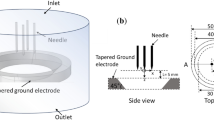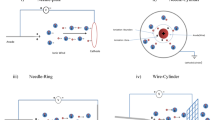Abstract
It is crucial to develop a green solid-state fan (SSF) with high corona wind intensity and minimal ozone emission. The application of a magnetic field might be a feasible alternative. A magnetic field enhanced SSF with a simple structure was proposed. This research used a physical model to quantitatively investigate the effects of a magnetic field on corona wind velocity and body force. Under the influence of a magnetic field, the variation of voltammetry characteristics, corona wind strength, flow distribution, and ozone concentration were explored experimentally using a prototype SSF. With the aid of a magnetic field, the corona wind velocity and body force increased, according to the findings. The traveling route of electrons seems to shift rapidly. The SSF with a magnetic field has a lower corona current, lower ozone formation, greater flow yield, and a decline in ozone molecules when compared to the SSF without a magnetic field. The greatest corona wind velocity measured was 2.54 m/s when a 6.5 kV-voltage, a 5 mm-discharge gap, and a 24.28 mT-magnetic flux intensity were applied. The outcomes of this study might aid in the improvement of corona wind intensity and the development of green SSFs for cooling electronics.


















Similar content being viewed by others
References
Wang J, Zhu T, Wang JB, Cai YX, Li XH (2020) Optimization of a green solid-state fan for electronics cooling applications. Sustain Energy Technol Assess 39:100703. https://doi.org/10.1016/j.seta.2020.100703
Huang RT, Sheu WJ, Wang CC (2009) Heat transfer enhancement by needle-arrayed electrodes—an EHD integrated cooling system. Energy Convers Manage 50(7):1789–1796. https://doi.org/10.1016/j.enconman.2009.03.017
Moreau E, Touchard G (2008) Enhancing the mechanical efficiency of electric wind in corona discharges. J Electrostat 66(1):39–44. https://doi.org/10.1016/j.elstat.2007.08.006
Fang Z, Liu Y, Cai LL (2012) Discharge characteristics of atmosphere pressure plasma jet in Ar. High Volt Eng 38(7):1613–1622. https://doi.org/10.3969/j.issn.1003-6520.2012.07.012 (in Chinese)
Li DR, Li BC, Zhang SJ (2018) Study on emission performance of low voltage and high density plasma electrode. Sci Technol Eng 18(2):1–6 (in Chinese)
Wang J, Zhu T, Cai YX, Zhang JF, Wang JB (2020) Review on the recent development of corona wind and its application in heat transfer enhancement. Int J Heat Mass Transf 152:119545. https://doi.org/10.1016/j.ijheatmasstransfer.2020.119545
Johnson MJ, Go DB (2017) Recent advances in electrohydrodynamic pumps operated by ionic winds: a review. Plasma Sources Sci Technol 26:103002. https://doi.org/10.1088/1361-6595/aa88e7
Feng J, Wang CH, Liu QM, Wu CL (2019) Enhancement of heat transfer via corona discharge by using needle-mesh and needle-fin electrodes. Int J Heat Mass Transf 130:640–649. https://doi.org/10.1016/j.ijheatmasstransfer.2018.10.103
Wang J, Zhu T, Cai YX, Wang JB, Wang J (2020) Development and application of a solid-state fan for enhanced heat dissipation. Appl Therm Eng 169:114922. https://doi.org/10.1016/j.applthermaleng.2020.114922
Zhang JF, Kong LJ, Qu JG, Wang S, Qu ZG (2019) Numerical and experimental investigation on configuration optimization of the large-size ionic wind pump. Energy 171:624–630. https://doi.org/10.1016/j.energy.2019.01.086
Wang JB, Li XH, Wang J, Zhu T, Bao YC (2020) Thermal performance evaluation of a thermoelectric cooler coupled with corona wind. Appl Therm Eng 179:115753. https://doi.org/10.1016/j.applthermaleng.2020.115753
Lee SJ, Li L, Kwon K, Kim W, Kim D (2015) Parallel integration of ionic wind generators on PCBs for enhancing flow rate. Microsyst Technol 21(7):1465–1471. https://doi.org/10.1007/s00542-014-2320-7
Rickard M, Dunn-Rankin D (2007) Numerical simulation of a tubular ion-driven wind generator. J Electrostat 65:646–654. https://doi.org/10.1016/j.elstat.2007.04.003
Moreau E, Benard N, Alicalapa F, Douyèreb A (2015) Electrohydrodynamic force produced by a corona discharge between a wire active electrode and several cylinder electrodes–application to electric propulsion. J Electrostat 76:194–200. https://doi.org/10.1016/j.elstat.2015.05.025
Mi JF, Xu DX, Sun YH, Du SN, Chen Y (2008) Influence of magnetic fields on negative corona discharge currents. J Electrostat 66:457–462. https://doi.org/10.1016/j.elstat.2008.04.010
Kim JG, Jung JS (2019) Application of a magnetic flux in the corona discharge zone to improve ion thrust via ion acceleration. J Electr Eng Technol 14:1683–1688. https://doi.org/10.1007/s42835-019-00204-y
Zhou DS, Tang JF, Kang PT, Wei LQ, Zhang CH (2018) Effects of magnetic field intensity on ionic wind characteristics. J Electrostat 96:99–103. https://doi.org/10.1016/j.elstat.2018.10.007
Zeng MJ, Zhang Q, Zhang XM, Zhang JF (2020) Study and performance optimization of large–section needle–ring ionic wind generator. China Sci Paper 15(3):341–346 (in Chinese)
Ahmedou SO, Havet M (2009) Effect of process parameters on the EHD airflow. J Electrostat 67(2–3):222–227. https://doi.org/10.1016/j.elstat.2009.01.055
Ghazanchaei M, Adamiak K, Castle Peter GS (2015) Predicted flow characteristics of a wire-nonparallel plate type electrohydrodynamic gas pump using the finite element method. J Electrostat 73:103–111. https://doi.org/10.1016/j.elstat.2014.11.003
Liao RJ, Wu FF, Liu XH, Yang F, Yang LJ, Zhou Z, Zhai L (2012) Numerical simulation of transient space charge distribution of DC positive corona discharge under atmospheric pressure air. Acta Phys Sin 61(24):370–380 (in Chinese)
Tran T N, Golosnoy I O, Lewin P L, Georghiou G E (2009) Two dimensional studies of trichel pulses in air using the finite element method. In: Annual report conference of electrical insulation and dielectric phenomena, Virginia, USA, pp. 592–595. https://doi.org/10.1109/CEIDP.2009.5377737
Wang ML, Qian R, Zhuo SJ, Chen Q, Li ZQ, Zhao B (2020) Larmor precession: observation and utilization for boosting the signal intensity of radio frequency glow discharge mass spectrometry. Anal Chem 92(14):9528–9535. https://doi.org/10.1021/acs.analchem.0c00588
Xu DX, Sheng LX, Wang HJ, Sun YH, Zhang XY, Mi JF (2007) Study of magnetically enhanced corona pre-charger. J Electrostat 65:101–106. https://doi.org/10.1016/j.elstat.2006.07.007
Park JY, Kim GH, Kim JD, Koh HS, Lee DC (1998) NOx removal using DC corona discharge with magnetic field. Combust Sci Technol 133(1–3):65–77. https://doi.org/10.1080/00102209808952027
Rapp D, Englander-Golden P (1965) Total cross sections for ionization and attachment in gases by electron impact. I. Positive ionization. J Chem Phys 43:1464–1479. https://doi.org/10.1063/1.1696957
Itikawa Y (2006) Cross sections for electron collisions with nitrogen molecules. J Phys Chem Ref Data 35(1):31–53
Song MM, Zhou QH, Sun Q, Yang W, Dong Y (2021) Application of coulomb collision cross-section in particle-in-cell simulation of plasma. High Power Laser Part Beams 33(03):88–96. https://doi.org/10.11884/HPLPB202133.200179 (in Chinese)
Naidis GV (1992) Modeling of plasma chemical processes in stable corona discharges at thin wires. J Phys D 25(3):477–480. https://doi.org/10.1088/0022-3727/25/3/021
Kawamoto H, Umezu S (2008) Electrostatic micro-ozone fan that utilizes ionic wind induced in pin-to-plate corona discharge system. J Electrostat 66(7–8):445–454. https://doi.org/10.1016/j.elstat.2008.04.009
Yagi S, Tanaka M (1979) Mechanism of ozone generation in air-fed ozonisers. J Phys D 12(9):1509–1520
Takaki K, Chang JS, Kostov KG (2004) Atmospheric pressure of nitrogen plasmas in a ferro-electric packed bed barrier discharge reactor. IEEE Trans Dielectr Electr Insul 11(3):481–490. https://doi.org/10.1109/TDEI.2004.1306726
Chen JH, Davidson JH (2002) Ozone production in the positive DC corona discharge: model and comparison to experiments. Plasma Chem Plasma Process 22(4):495–522. https://doi.org/10.1023/A:1021315412208
Acknowledgements
The authors would like to express their gratitude to the support by ‘the Natural Science Foundation of Jiangsu Province (Grants No. BK20181446)’, ‘Key Laboratory of Low-grade Energy Utilization Technologies and Systems (Chongqing University, Grants No. LLEUTS-202008)’, ‘the Foundation of Key Laboratory of Thermo-Fluid Science and Engineering (Xi'an Jiaotong University, Grants No. KLTFSE2019KFJJ01)’, and ‘A Project Funded by the Priority Academic Program Development of Jiangsu Higher Education Institutions (PAPD)’.
Author information
Authors and Affiliations
Corresponding author
Ethics declarations
Conflict of interest
There are no conflicts to declare.
Additional information
Publisher's Note
Springer Nature remains neutral with regard to jurisdictional claims in published maps and institutional affiliations.
Rights and permissions
About this article
Cite this article
Wang, J., Cai, Rj., Zhu, T. et al. Ionic Wind Intensity Enhancement and Ozone Reduction in a Solid-State Fan Via Electromagnetic Field Action. Plasma Chem Plasma Process 42, 1045–1067 (2022). https://doi.org/10.1007/s11090-022-10273-z
Received:
Accepted:
Published:
Issue Date:
DOI: https://doi.org/10.1007/s11090-022-10273-z




